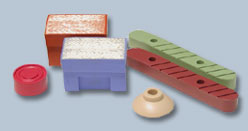Rubber Compounds

Different applications for molded rubber products require different compounds. When negotiating new jobs, our extensive experience in the field of custom moldings qualifies us to recommend the appropriate rubber compound, if required. To assist our customers, and potential customers, in choosing the appropriate material for a given application, below we've included a list of the nine most common rubber compounds that we mold and the properties of each.
BUNA-N
The nitrile elastomers Buna-N and NBR are noted for their outstanding resistance to solvents, oils, and fuels of various kinds. They also have excellent compression-set and tensile strength, and both have good performance over a wide range of temperatures. Nitrile can be compounded to remain flexible in low temperatures but has poor ozone and weather resistance.
BUTYL
Butyl has excellent impermeability from gases, excellent dielectric properties, good resistance to tearing, good aging properties at elevated temperatures, and good chemical stability. Butyl also resists weathering, sunlight, ozone, mineral acids, oxygenated solvents, water absorption, corona discharge, and animal and vegetable oils. Resistance to flexing and abrasion is also excellent. Butyl should not be used where resistance to oil or hydrocarbon solvents is required; however, it does have excellent resistance to oxygenated solvents.
EPDM
EPDM, or ethylene propylene diene monomer, is used extensively in outdoor applications. This elastomer can withstand all types of weather including sunlight, ozone, and oxidants. EPDM has excellent resistance to animal and vegetable oils, water, steam, and oxygenated solvents. EPDM also has good dielectric qualities and a high heat resistance. In addition to high heat, the compound's low temperature properties are excellent as well. EPDM has excellent chemical resistance but is unsuitable for use with oil or hydrocarbon solvents.
FLUOROELASTOMERS
Fluoroelastomers, better known by DuPont's trade name Viton� or 3M's trade name Fluorel�, are a high performance synthetic rubber with exceptional resistance to oils and chemicals at elevated temperatures. Products that require resistance to high temperatures and caustic fluids, such as o-rings, oil seals, and gaskets, are made from this material. Although fluoroelastomers are high priced materials, their many exceptional qualities, including an extremely long useful life, usually outweigh their initial costs over time.
NATURAL RUBBER
Natural rubber is excellent as a general-purpose elastomer: it offers a good balance of superior tear strength, high resilience and tensile strength, good abrasion resistance, and good flexural qualities at low temperatures. Natural Rubber should not be used where it will be exposed to chemicals or oil. Also, it does not stand up well in outdoor use where it is subjected to oxygen, sunlight, ozone, and temperature extremes.
NEOPRENE�
Neoprene� is DuPont's trade name for polychloroprene elastomer. Neoprene� has good resistance to oils, hydraulic fluids, grease, and ozone attack. In addition, it will not support flame and is self extinguishing. It has excellent heat resistance and is abrasion resistant and durable. Neoprene withstands fluctuations in temperature but fairs poorly in consistently low temperatures.
SBR
SBR, an abbreviation for styrene-butadiene, is a general-purpose, versatile elastomer with above average flexibility, resilience, and abrasive resistance. SBR has good weathering characteristics and is resistant to mild-to-moderate chemicals, organic acids, and alcohols. SBR is easily formulated with high styrene resins to produce tough, hard rubber applications. Compounding with other elastomers greatly improves its oil and solvent resistance.
SILICONE
Silicone, or polysiloxane, is a stable elastomer that retains its elasticity in temperature extremes (-150 to 500� F). Silicone has inherent resistance to ozone attack, ultraviolet light, corona discharge, moisture, and chemical attack. Silicone also has good tensile strength, elongation, compression-set, and abrasion resistance. Finally, silicone is characterized by its excellent electrical insulation properties.
URETHANE
Urethane has unusually good physical properties such as abrasion resistance, tear strength, tensile strength, shock absorption, and elongation. In addition, urethane also has excellent chemical properties such as resistance to solvents, ozone, and oxygen. However, urethane does have limited high temperature resistance and poor resistance to hot water, steam, and hydrolytic agents.
|